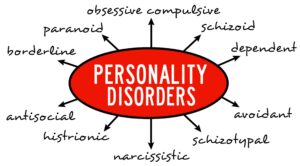According to statistics provided by the National Institute of Mental Health, about 10% of U.S. adults aged 18 and older have a personality or borderline personality disorder. The Diagnostic and Statistical Manual on Mental Disorders, Fifth Edition (DSM-5) defines personality disorders as those that represent “an enduring pattern of inner experience and behavior that deviates markedly from the expectations of the individual’s culture.” People with borderline personality disorders may experience those same fluctuations in behavior, albeit in spurts that last a few hours to days.
The data also shows that personality disorders can affect anyone, with sex and race not found to be associated with the prevalence of the conditions. Additionally, nearly 85% of those diagnosed with a personality disorder had one or more other mental disorders. Despite the severity and high incidence of personality disorders nationwide, the conditions remain a mystery to most people outside of a vague understanding that’s often shaped by fictional characters in movies or on television.
To provide some context and clarity on personality disorders for those who feel they or a loved one may have a diagnosable condition, we wanted to explore the topic further. Read on as we dive deep into the different types, causes, symptoms, and treatments for the many personality disorders one can experience.
Types of Personality Disorders
 While there are many variations of personality disorders — and we’ll get to each of the most frequently diagnosed in a bit — personality disorders are generally grouped into three main clusters. These clusters, known as Cluster A, Cluster B, and Cluster C, consider the person’s behaviors, signs, and symptoms.
While there are many variations of personality disorders — and we’ll get to each of the most frequently diagnosed in a bit — personality disorders are generally grouped into three main clusters. These clusters, known as Cluster A, Cluster B, and Cluster C, consider the person’s behaviors, signs, and symptoms.
Cluster A Personality Disorders
Cluster A includes personality disorders involving odd or eccentric behavior, including:
Paranoid personality disorder – As the name implies, this personality disorder is marked by the presence of paranoia or mistrust and suspicion of others without any valid reasoning. It’s incredibly common for those with paranoid personality disorder to invent or create situations in which they believe something or someone is aiming to threaten, harm, or belittle them or their feelings. The result can be sudden and severe outbursts of anger.
Schizoid personality disorder – Someone with schizoid personality disorder is likely to withdraw from interpersonal relationships, detaching themselves from both reality and social situations. Because people with this type of personality disorder often find themselves emotionally cold and disconnected from others, it’s unusual for them to be able to experience a wide range of emotions. Brooding with introspection is a good way to describe someone with schizoid personality disorder.
Schizotypal personality disorder – A person with schizotypal personality disorder may exhibit eccentric behaviors in how they dress, think, or speak. These actions are typically accompanied by inappropriate or ill-suited behaviors, like talking to themselves, participating in strange conversations, and struggling to form meaningful relationships. Someone with this personality disorder may also believe they can see the future or be able to influence events with just their mind.
Cluster B Personality Disorders
While Cluster A is designated for people with behavior that may be out of character or unusual, the personality disorders in Cluster B are reserved for people who act erratically, are unpredictable, or fail to control their emotions. These conditions include:
Antisocial personality disorder – Those with antisocial personality disorder typically neglect to consider how their actions might impact others. As a result, these people may be more willing to bend the rules, lie, steal, and defraud others in order to get something as long as it benefits them. Antisocial personality disorder is sometimes more casually referred to as being selfish, especially because these people generally show little remorse or guilt. Interestingly, antisocial personality disorder regularly manifests in childhood, with those people at high risk of developing problems with substance abuse or alcoholism down the road.
Histrionic personality disorder – A strong urge to garner attention is a classic symptom of histrionic personality disorder. People with this condition may be sexually provocative, overly dramatic, easily influenced by others, obsessive about their appearance, and emotional when faced with criticism or the thought of being ignored. Someone with this condition must feel like they are the center of attention at all times.
Borderline personality disorder – We mentioned this one earlier, but it bears repeating as a Cluster B diagnosis. Borderline personality disorder is associated with mood swings, impulsive behavior, and an inability to regulate one’s emotions. Like those with a histrionic personality disorder, these people may act irresponsibly sexually, in addition to binge drinking and gambling. In some cases, those with this condition will also threaten suicide to acquire attention from others.
Narcissistic personality disorder – Of all the terms used to describe the behaviors associated with personality disorders, narcissism is one of the most commonly used by those who lack specialized knowledge on the topic. A person with narcissistic personality disorder will typically have an inflated sense of self-importance. In order to feed their own ego, they blatantly brag about their successes, looks, power, or material possessions. They’re also willing to take advantage of others if it means access to more praise or conquests.
Cluster C Personality Disorders
Lastly, Cluster C personality disorders involve conditions that invoke intense feelings of fear or anxiety, such as:
Dependent personality disorder – People with a dependent personality disorder will often lack self-confidence or a willingness to do things on their own. Because of this, they may enable others to take responsibility for parts of their life and put the wants and needs of others above their own. In essence, they are “yes” people who don’t feel confident saying no or standing up for themselves because of a fear of disapproval or rejection. Ultimately, these behaviors can cause a feeling of hopelessness or a fear of being alone, which is why so many with this condition look to start a new romantic relationship at the immediate close of another.
Avoidant personality disorder – Fearful feelings of being judged negatively are common in those who struggle with avoidant personality disorder. For most people with this condition, social situations become incredibly uncomfortable, with prevalent cognitive distortions led by catastrophizing events. Therefore, it’s unusual for a person with avoidant personality disorder to develop meaningful relationships with people outside their inner circle of friends and family members.
Obsessive-compulsive personality disorder – Obsessive-compulsive personality disorder is not to be confused with obsessive-compulsive disorder (OCD), which describes one’s specific behavior, including repetitive steps or actions prompted by feelings of anxiety. Someone with obsessive-compulsive personality disorder may set high standards for themselves, even to the point of unattainability. A strong desire to control others and situations is common in people with this condition. In addition, they may be very cautious and so overly methodical that it hinders their ability to act.
In an expert Q&A posted on the official website for the American Psychiatric Association on personality disorders, a medical doctor and research professor at the University of Arizona citing DSM-5 acknowledged that a person could receive more than one personality disorder diagnosis.
“People who are diagnosed with a personality disorder most often qualify for more than one diagnosis,” Andrew Skodol, M.D., writes. “A person with a severe personality disorder might meet the criteria for four, five or even more disorders! In practice, clinicians usually recognize that meeting more criteria for personality disorders means more severe disorder.”
Causes of Personality Disorders
While researchers and medical professionals know a great deal about the different types of personality disorders, what’s considerably less clear is exactly what causes these conditions to occur.
Despite that lack of awareness, most in the industry attribute the cause of personality disorders to include one or more of the following: biological factors, environmental influencers from childhood, and event-related trauma. Of course, that all makes sense considering that your personality is an inward and outward grouping of your thoughts, emotions, beliefs, feelings, and actions — basically all the things that make you, you.
As the Cleveland Clinic reports, scientists have discovered the presence of a gene malfunction that could impact certain personality disorders, including obsessive-compulsive personality disorder. Further, the Cleveland Clinic says, researchers continue to probe deeper into genetic correlations to common personality disorder traits like aggression, anxiety, and fear.
Researchers have noted that people with certain personality disorders also experience changes in their brains. For instance, someone with paranoid personality disorder could develop altered amygdala functioning — the part of the brain that processes fear and feelings of risk or threat. Studies on schizotypal personality disorder also uncovered a volumetric decrease, or shrinkage, in the frontal lobe of patients’ brains, which may affect cognition.
Traumatic events are one of the most significant causes and the easiest to identify. Researchers have linked borderline personality disorder with childhood sexual trauma, while other conditions involving the person shying away from social settings have also been associated with childhood abuse. It’s not uncommon for one’s upbringing to heavily affect a future personality disorder. In fact, one study showed that people who experienced verbal abuse as children were three times as likely to pick up borderline, narcissistic, obsessive-compulsive, or paranoid personality disorders upon reaching adulthood.
While it’s clear and apparent how and why an abusive situation could cause a personality disorder later in life, other causes are more of a mystery. For example, we know that Asian countries like Taiwan, China, and Japan have very low cases of antisocial personality disorders — but very high cases of Cluster C personality disorders.
As mentioned, there are times when multiple causes may contribute to a personality disorder. For instance, someone may be born into a family with a history of personality disorders and then experience a traumatic event that triggers their own condition or worsens sensations they are already feeling.
Symptoms of a Personality Disorder
The brain is an incredibly complicated body part, and as you’ve learned here, there are some aspects of it that even longtime medical researchers still can’t fully grasp. The complexity of what someone experiences when in the throes of a personality disorder can be overwhelming and cause feelings of isolation.
While symptoms for each of the different types of personality disorders can vary, the Cleveland Clinic places symptoms into two distinct buckets: relationships and identity/sense of self.
Symptoms involving relationships will generally stem from the fact that someone with a personality disorder will often fail to form close or meaningful relationships because of their erratic, reckless, unusual, or selfish behavior. On the flip side, people with some personality disorders are OK living life without those relationships because they are antisocial or avoid expanding friend groups outside of their inner circle.
With regard to identity/sense of self, people with personality disorders struggle with seeing themselves for who (and how) they really are. That can mean self-esteem that is either too high or low or behaviors that fluctuate based on the situation or people they are with at the time.
Another commonality among personality disorder symptoms is that the person experiencing them can be incapable of recognizing what they’re going through. Even when confronted by a friend or family member about their behavior, this person may either deny the problem, attempt to normalize it by providing a rationalization, or blame someone else for their own actions.
It’s also important to note that symptoms can change — either intensifying or decreasing — in time. As Andrew Skodol, M.D., writes, “Studies show that a fair number of children and early adolescents report signs and symptoms consistent with a personality disorder. For many, these symptoms decrease over time.”
Still, a child with symptoms of a personality disorder at a young age runs the risk of being diagnosed in early adulthood. For that reason, many clinics and therapists are more proactive than ever in attempting to identify symptoms in children and working collaboratively on treatment to make an impact before the condition lingers or becomes worse.
Treatment for Personality Disorders
 Remember how we talked about the complexities of personality disorders? One of them involves treatment. What makes treatment for personality disorders so challenging for clinics, therapists, and medical professionals is that many patients simply don’t recognize the severity of their behavior and don’t seek out help. In cases like this, treatment can only occur if a friend or family member intervenes, and the person agrees to get assistance.
Remember how we talked about the complexities of personality disorders? One of them involves treatment. What makes treatment for personality disorders so challenging for clinics, therapists, and medical professionals is that many patients simply don’t recognize the severity of their behavior and don’t seek out help. In cases like this, treatment can only occur if a friend or family member intervenes, and the person agrees to get assistance.
Another hurdle to overcome is the fact that there are no approved medications for personality disorders. There are drugs one can take to help ease or alleviate some of the symptoms associated with personality disorder, but a medication to address the root cause is not currently available.
That said, there are some things that can be done to focus on both the symptoms and the root cause, including psychotherapy. Psychotherapy is the medical term for talk therapy, which usually entails discussing your experiences and what you’re feeling with either a therapist and/or in a group setting. You may have also heard the term cognitive behavioral therapy, or CBT, used when describing psychotherapy.
The concept behind CBT is that our thoughts and behaviors influence how we feel. Thus, talking about those thoughts and behaviors gives us a chance to develop coping skills to react to triggering situations in a more productive way. For example, someone with a negative self-image can use CBT to control their thoughts, batting away negative notions of worthlessness in favor of healthier language.
Because CBT is a catch-all term for a broad swath of psychotherapy, there are other types of treatment modalities that fall beneath it. Dialectical behavior therapy (DBT) is a specific type of CBT that can be used for people who exhibit extreme emotional reactions.
DBT is often used to treat borderline personality disorder because it helps patients control impulses and emotional responses, relying heavily on mindfulness. In helping to ground patients and recognize what’s real versus fantasy, DBT can be effective in treating people who struggle with chronic thoughts of self-harm or suicide.
Whether it’s one-on-one counseling, group therapy, CBT, or DBT, you should know that any good therapist will take the person’s unique experiences into consideration before deciding on a treatment plan. The reality is that there is no one-size-fits-all plan for using psychotherapy to treat a personality disorder, so it’s essential that the therapist understands exactly what the person is feeling in order to develop the most effective treatment plan possible.
For most people with a personality disorder, psychotherapy is a long-term tool that shouldn’t be viewed as a quick fix.
Rising Phoenix is Here to Help with Your Mental Health Needs
We understand that bouts of anxiety, depression, and other mental health concerns are a part of life, but when those sensations manifest into a personality disorder, you owe it to yourself to find help. Rising Phoenix Wellness Services has programs in place specifically for personality disorders that can help you overcome what you’re feeling with evidence-based psychotherapy.
Our admissions advisor is available 24-7 to help with confidential verifications of insurance benefits and to answer any questions you or a loved one may have. Reach out to us today to learn more about how we can help you with your personality disorder.

